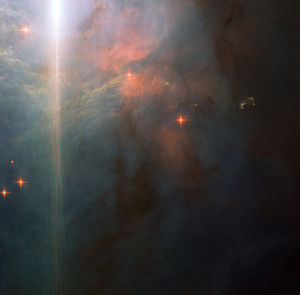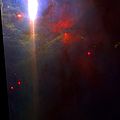- NGC 2023
-
NGC 2023 
NGC 2023 picture created from multiple images taken with the Wide Field Camera of Hubble’s Advanced Camera for Surveys.Observation data: J2000 epoch Type Reflection and Emission Right ascension 05h 41m 37.9s[1] Declination −02° 15′ 52″ Distance 1467.7 ly Apparent dimensions (V) 10′x10′ Constellation Orion Physical characteristics Other designations NGC 2023 , LBN 954, VDB 52, [XT95] 6, GN 05.39.1.02, RAFGL 806, [NYS99] C-23, IRAS 05391-0217, RX J0541.8-0217, [RK68] 38 See also: Diffuse nebula, Lists of nebulae The reflection nebula NGC 2023 is in the constellation Orion. It is one of the brightest sources of fluorescent molecular hydrogen, and at 4 light-years wide it is one of the largest in the sky. It is powered by the B star (B1.5) HD 37903, the most luminous member of a cluster of young stellar objects illuminating the front surface of the Lynds 1630 molecular cloud (Barnard 33) in Orion B.
NGC 2023 forms a cavity in the surface of the cloud, some 450 parsecs from Earth. It produces a bright visual reflection nebula and an ultraviolet-excited photodissociation region. It is about a third of a degree from the Horsehead Nebula and is often included (but not indicated) in images of that object.
Gallery
-
South part of NGC 2023 by HST, 3′ view
External links
- NGC 2023 on WikiSky: DSS2, SDSS, GALEX, IRAS, Hydrogen α, X-Ray, Astrophoto, Sky Map, Articles and images
Astronomical catalogs NGC: NGC 2021 - NGC 2022 - NGC 2023 - NGC 2024 - NGC 2025 Coordinates:
 05h 41m 37.9s, +02° 15′ 52″
05h 41m 37.9s, +02° 15′ 52″References
- ^ "SIMBAD query result for NGC 2023". SIMBAD Astronomical Database. http://simbad.u-strasbg.fr/simbad/sim-id?Ident=NGC+2023. Retrieved 25 July 2011.
Categories:- Reflection nebulae
- Orion constellation
- NGC objects
-
Wikimedia Foundation. 2010.

